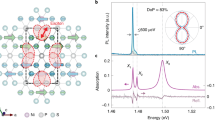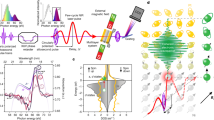Abstract
The interplay between light and matter is the basis of many fundamental processes and various applications1. Harnessing light–matter interactions in principle allows operation of solid state devices under new physical principles: for example, the a.c. optical Stark effect (OSE) has enabled coherent quantum control schemes of spins in semiconductors, with the potential for realizing quantum devices based on spin qubits2,3,4,5. However, as the dimension of semiconductors is reduced, light–matter coupling is typically weakened, thus limiting applications at the nanoscale. Recent experiments have demonstrated significant enhancement of nanoscale light–matter interactions, albeit with the need for a high-finesse cavity6,7, ultimately preventing device down-scaling and integration. Here we report that a sizable OSE can be achieved at substantial energy detuning in a cavity-free colloidal metal–semiconductor core–shell hetero-nanostructure, in which the metal surface plasmon is tuned to resonate spectrally with a semiconductor exciton transition. We further demonstrate that this resonantly enhanced OSE exhibits polarization dependence and provides a viable mechanism for coherent ultrafast spin manipulation within colloidal nanostructures. The plasmon–exciton resonant nature further enables tailoring of both OSE and spin manipulation by tuning plasmon resonance intensity and frequency. These results open a pathway for tailoring light–matter–spin interactions through plasmon–exciton resonant coupling in a judiciously engineered nanostructure, and offer a basis for future applications in quantum information processing at the nanoscale. More generally, integrated nanostructures with resonantly enhanced light–matter interactions should serve as a test bed for other emerging fields, including nano-biophotonics and nano-energy8,9.
This is a preview of subscription content, access via your institution
Access options
Subscribe to this journal
Receive 51 print issues and online access
$199.00 per year
only $3.90 per issue
Buy this article
- Purchase on Springer Link
- Instant access to full article PDF
Prices may be subject to local taxes which are calculated during checkout




Similar content being viewed by others
References
Weiner, J. & Ho, P.-T. Light-matter Interaction: Fundamentals and Applications (Wiley & Sons, 2003)
Awschalom, D. D., Loss, D. & Samarth, N. (eds) Semiconductor Spintronics and Quantum Computation (Springer, 2002)
Gupta, J. A., Knobel, R., Samarth, N. & Awschalom, D. D. Ultrafast manipulation of electron spin coherence. Science 292, 2458–2461 (2001)
Press, D., Ladd, T. D., Zhang, B. & Yamamoto, Y. Complete quantum control of a single quantum dot spin using ultrafast optical pulses. Nature 456, 218–221 (2008)
Berezovsky, J., Mikkelsen, M. H., Stoltz, N. G., Coldren, L. A. & Awschalom, D. D. Picosecond coherent optical manipulation of a single electron spin in a quantum dot. Science 320, 349–352 (2008)
Reithmaier, J. P. et al. Strong coupling in a single quantum dot-semiconductor microcavity system. Nature 432, 197–200 (2004)
Khitrova, G., Gibbs, H. M., Kira, M., Koch, S. W. & Scherer, A. Vacuum Rabi splitting in semiconductors. Nature Phys. 2, 81–90 (2006)
Dubowski, J. J. &, Tanev, S. (eds) Photon-based Nanoscience and Nanobiotechnology (Springer, 2006)
Atwater, H. A. & Polman, A. Plasmonics for improved photovoltaic devices. Nature Mater. 9, 205–213 (2010)
Joffre, M., Hulin, D., Migus, A. & Combescot, M. Laser-induced exciton splitting. Phys. Rev. Lett. 62, 74–77 (1989)
Unold, T., Mueller, K., Lienau, C., Elaesser, T. & Wieck, A. D. Optical Stark effect in a quantum dot: ultrafast control of single exciton. Phys. Rev. Lett. 92, 157401 (2004)
Maier, S. A. & Atwater, H. A. Plasmonics: localization and guiding of electromagnetic energy in metal/dielectric structures. J. Appl. Phys. 98, 011101 (2005)
Anker, J. N. et al. Biosensing with plasmonic nanosensors. Nature Mater. 7, 442–453 (2008)
Vasa, P. et al. Coherent exciton-surface-plasmon-polariton interaction in hybrid metal-semiconductor nanostructures. Phys. Rev. Lett. 101, 116801 (2008)
Yang, Y., Shi, J., Chen, H., Dai, S. & Liu, Y. Enhanced off-resonance optical nonlinearities of Au@CdS core-shell nanoparticles embedded in BaTiO3 thin films. Chem. Phys. Lett. 370, 1–6 (2003)
Durach, M., Rusina, A., Klimov, V. I. & Stockman, M. I. Nanoplasmonic renormalization and enhancement of Coulomb interactions. Proc. SPIE 7032, 70320J (2008)
Zhang, W., Govorov, A. O. & Bryant, G. W. Semiconductor-metal nanoparticle molecules: hybrid excitons and the nonlinear Fano effect. Phys. Rev. Lett. 97, 146804 (2006)
Zhang, J., Tang, Y., Lee, K. & Ouyang, M. Nonepitaxial growth of hybrid core-shell nanostructures with large lattice mismatches. Science 327, 1634–1638 (2010)
Battaglia, D., Li, J. J., Wang, Y. & Peng, X. Colloidal two-dimensional systems: CdSe quantum shells and wells. Angew. Chem. Int. Edn 42, 5035–5039 (2003)
Tsuda, S. & Brito Cruz, C. H. Femtosecond dynamics of the optical Stark effect in semiconductor-doped glass. Appl. Phys. Lett. 68, 1093–1095 (1996)
Gupta, J. A. & Awschalom, D. D. Spin precession and the optical Stark effect in a semiconductor-doped glass. Phys. Rev. B 63, 085303 (2001)
Pryor, C. E. & Flatté, M. E. Predicted ultrafast single-qubit operations in semiconductor quantum dots. Appl. Phys. Lett. 88, 233108 (2006)
Gupta, J. A. et al. Spin dynamics in semiconductor nanocrystals. Phys. Rev. B 66, 125307 (2002)
Ouyang, M. & Awschalom, D. D. Coherent spin transfer between molecularly bridged quantum dots. Science 301, 1074–1078 (2003)
Berezovsky, J. et al. Spin dynamics and level structure of quantum-dot quantum wells. Phys. Rev. B 71, 081309 (2005)
Berezovsky, J. et al. Initialization and read-out of spins in coupled core-shell quantum dots. Nature Phys. 2, 831–834 (2006)
Janben, N., Whitaker, K. M., Gamelin, D. R. & Bratschitsch, R. Ultrafast spin dynamics in colloidal ZnO quantum dots. Nano Lett. 8, 1991–1994 (2008)
Beaulac, R., Schneider, L., Archer, P. I., Bacher, G. & Gamelin, D. R. Light-induced spontaneous magnetization in doped colloidal quantum dots. Science 325, 973–976 (2009)
Lewis, N. S. Toward cost-effective energy use. Science 315, 798–801 (2007)
Acknowledgements
We acknowledge funding from an ONR YIP award (N000140710787), an NSF CAREER award (DMR-0547194), and a Beckman YIP grant (0609259093). We also thank P. Kolb and A. O. Govorov for discussions.
Author information
Authors and Affiliations
Contributions
J.Z. performed all materials synthesis, and some of characterizations and measurements. Y.T. and K.L. contributed to sample characterizations. M.O. formulated the idea, performed some of measurements, wrote the manuscript, and supervised and coordinated the research. All co-authors participated in discussion and manuscript writing.
Corresponding author
Ethics declarations
Competing interests
The authors declare no competing financial interests.
Supplementary information
Supplementary Information
This file contains Supplementary Methods, Supplementary Figures S1-S11 with legends, Supplementary Discussions and References. (PDF 4622 kb)
Rights and permissions
About this article
Cite this article
Zhang, J., Tang, Y., Lee, K. et al. Tailoring light–matter–spin interactions in colloidal hetero-nanostructures. Nature 466, 91–95 (2010). https://doi.org/10.1038/nature09150
Received:
Accepted:
Issue Date:
DOI: https://doi.org/10.1038/nature09150
This article is cited by
-
Synthesis and Modulation of Low-Dimensional Transition Metal Chalcogenide Materials via Atomic Substitution
Nano-Micro Letters (2024)
-
Room-temperature coherent optical manipulation of hole spins in solution-grown perovskite quantum dots
Nature Nanotechnology (2023)
-
Plasmonic Copper: Ways and Means of Achieving, Directing, and Utilizing Surface Plasmons
Plasmonics (2023)
-
Fundamentals and photocatalytic hydrogen evolution applications of quaternary chalcogenide semiconductor: Cu2ZnSnS4
Rare Metals (2022)
-
Tailoring atomic diffusion for in situ fabrication of different heterostructures
Nature Communications (2021)
Comments
By submitting a comment you agree to abide by our Terms and Community Guidelines. If you find something abusive or that does not comply with our terms or guidelines please flag it as inappropriate.



